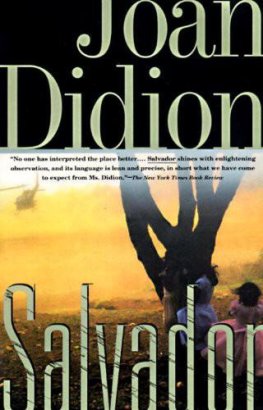Joan Didion - Vintage Didion
Here you can read online Joan Didion - Vintage Didion full text of the book (entire story) in english for free. Download pdf and epub, get meaning, cover and reviews about this ebook. year: 2004, publisher: Vintage Books, genre: Non-fiction. Description of the work, (preface) as well as reviews are available. Best literature library LitArk.com created for fans of good reading and offers a wide selection of genres:
Romance novel
Science fiction
Adventure
Detective
Science
History
Home and family
Prose
Art
Politics
Computer
Non-fiction
Religion
Business
Children
Humor
Choose a favorite category and find really read worthwhile books. Enjoy immersion in the world of imagination, feel the emotions of the characters or learn something new for yourself, make an fascinating discovery.
- Book:Vintage Didion
- Author:
- Publisher:Vintage Books
- Genre:
- Year:2004
- Rating:3 / 5
- Favourites:Add to favourites
- Your mark:
- 60
- 1
- 2
- 3
- 4
- 5
Vintage Didion: summary, description and annotation
We offer to read an annotation, description, summary or preface (depends on what the author of the book "Vintage Didion" wrote himself). If you haven't found the necessary information about the book — write in the comments, we will try to find it.
Vintage Didion — read online for free the complete book (whole text) full work
Below is the text of the book, divided by pages. System saving the place of the last page read, allows you to conveniently read the book "Vintage Didion" online for free, without having to search again every time where you left off. Put a bookmark, and you can go to the page where you finished reading at any time.
Font size:
Interval:
Bookmark:
Joan Didion
Vintage Didion
GIRL OF THE GOLDEN WEST
The domestic details spring to memory. Early on the evening of February 4, 1974, in her duplex apartment at 2603 Benvenue in Berkeley, Patricia Campbell Hearst, age nineteen, a student of art history at the University of California at Berkeley and a granddaughter of the late William Randolph Hearst, put on a blue terry-cloth bathrobe, heated a can of chicken-noodle soup and made tuna fish sandwiches for herself and her fianc, Steven Weed; watched Mission Impossible and The Magician on television; cleaned up the dishes; sat down to study just as the doorbell rang; was abducted at gunpoint and held blindfolded, by three men and five women who called themselves the Symbionese Liberation Army, for the next fifty-seven days.
From the fifty-eighth day, on which she agreed to join her captors and was photographed in front of the SLAs cobra flag carrying a sawed-off M-1 carbine, until September 18, 1975, when she was arrested in San Francisco, Patricia Campbell Hearst participated actively in the robberies of the Hibernia Bank in San Francisco and the Crocker National Bank outside Sacramento; sprayed Crenshaw Boulevard in Los Angeles with a submachine gun to cover a comrade apprehended for shoplifting; and was party or witness to a number of less publicized thefts and several bombings, to which she would later refer as actions, or operations.
On trial in San Francisco for the Hibernia Bank operation she appeared in court wearing frosted-white nail polish, and demonstrated for the jury the bolt action necessary to chamber an M-1. On a psychiatric test administered while she was in custody she completed the sentence Most men with the words are assholes. Seven years later she was living with the bodyguard she had married, their infant daughter, and two German shepherds behind locked doors in a Spanish-style house equipped with the best electronic security system available, describing herself as older and wiser, and dedicating her account of these events, Every Secret Thing, to Mom and Dad.
It was a special kind of sentimental education, a public coming-of-age with an insistently literary cast to it, and it seemed at the time to offer a parable for the period. Certain of its images entered the national memory. We had Patricia Campbell Hearst in her first-communion dress, smiling, and we had Patricia Campbell Hearst in the Hibernia Bank surveillance stills, not smiling. We again had her smiling in the engagement picture, an unremarkably pretty girl in a simple dress on a sunny lawn, and we again had her not smiling in the Tania snapshot, the famous Polaroid with the M-1. We had her with her father and her sister Anne in a photograph taken at the Burlingame Country Club some months before the kidnapping: all three Hearsts smiling there, not only smiling but wearing leis, the father in maile and orchid leis, the daughters in pikake, that rarest and most expensive kind of lei, strand after strand of tiny Arabian jasmine buds strung like ivory beads.
We had the bank of microphones in front of the Hillsborough house whenever Randolph and Catherine Hearst (Dad and Mom in the first spectral messages from the absent daughter, pig Hearsts as the spring progressed) met the press, the potted flowers on the steps changing with the seasons, domestic upkeep intact in the face of crisis: azaleas, fuchsias, then cymbidium orchids massed for Easter. We had, early on, the ugly images of looting and smashed cameras and frozen turkey legs hurled through windows in West Oakland, the violent result of the Hearsts first attempt to meet the SLA ransom demand, and we had, on television the same night, the news that William Knowland, the former United States senator from California and the most prominent member of the family that had run Oakland for half a century, had taken the pistol he was said to carry as protection against terrorists, positioned himself on a bank of the Russian River, and blown off the top of his head.
All of these pictures told a story, taught a dramatic lesson, carrying as they did the frisson of one another, the invitation to compare and contrast. The image of Patricia Campbell Hearst on the FBI wanted fliers was for example cropped from the image of the unremarkably pretty girl in the simple dress on the sunny lawn, schematic evidence that even a golden girl could be pinned in the beam of history. There was no actual connection between turkey legs thrown through windows in West Oakland and William Knowland lying facedown in the Russian River, but the paradigm was manifest, one California busy being born and another busy dying. Those cymbidiums on the Hearsts doorstep in Hillsborough dissolved before our eyes into the image of a flaming palm tree in south-central Los Angeles (the model again was two Californias), the palm tree above the stucco bungalow in which Patricia Campbell Hearst was believed for a time to be burning to death on live television. (Actually, Patricia Campbell Hearst was in yet a third California, a motel room at Disneyland, watching the palm tree burn as we all were, on television, and it was Donald DeFreeze, Nancy Ling Perry, Angela Atwood, Patricia Soltysik, Camilla Hall, and William Wolfe, one black escaped convict and five children of the white middle class, who were dying in the stucco bungalow.)
Not only the images but the voice told a story, the voice on the tapes, the depressed voice with the California inflection, the voice that trailed off, now almost inaudible, then a hint of whine, a schoolgirls sarcasm, a voice every parent recognized: Mom, Dad. Im OK. I had a few scrapes and stuff, but they washed them up. I just hope youll do what they say, Dad. If you can get the food thing organized before the nineteenth then thats OK. Whatever you come up with is basically OK, it was never intended that you feed the whole state. I am here because I am a member of a ruling-class family and I think you can begin to see the analogy. People should stop acting like Im dead, Mom should get out of her black dress, that doesnt help at all. Mom, Dad I dont believe youre doing all you can Mom, Dad Im starting to think that no one is concerned about me anymore. And then: Greetings to the people. This is Tania.
Patricia Campbell Hearsts great-grandfather had arrived in California by foot in 1850, unschooled, unmarried, thirty years old with few graces and no prospects, a Missouri farmers son who would spend his thirties scratching around El Dorado and Nevada and Sacramento counties looking for a stake. In 1859 he found one, and at his death in 1891 George Hearst could leave the schoolteacher he had married in 1862 a fortune taken from the ground, the continuing proceeds from the most productive mines of the period, the Ophir in Nevada, the Homestake in South Dakota, the Ontario in Utah, the Anaconda in Montana, the San Luis in Mexico. The widow, Phoebe Apperson Hearst, a tiny, strong-minded woman then only forty-eight years old, took this apparently artesian income and financed her only child in the publishing empire he wanted, underwrote a surprising amount of the campus where her great-granddaughter would be enrolled at the time she was kidnapped, and built for herself, on sixty-seven thousand acres on the McCloud River in Siskiyou County, the original Wyntoon, a quarried-lava castle of which its architect, Bernard Maybeck, said simply: Here you can reach all that is within you.
The extent to which certain places dominate the California imagination is apprehended, even by Californians, only dimly. Deriving not only from the landscape but from the claiming of it, from the romance of emigration, the radical abandonment of established attachments, this imagination remains obdurately symbolic, tending to locate lessons in what the rest of the country perceives only as scenery. Yosemite, for example, remains what Kevin Starr has called one of the primary California symbols, a fixed factor of identity for all those who sought a primarily Californian aesthetic. Both the community of and the coastline at Carmel have a symbolic meaning lost to the contemporary visitor, a lingering allusion to art as freedom, freedom as craft, the bohemian pantheism of the early twentieth century. The Golden Gate Bridge, referring as it does to both the infinite and technology, suggests, to the Californian, a quite complex representation of lands end, and also of its beginning.
Font size:
Interval:
Bookmark:
Similar books «Vintage Didion»
Look at similar books to Vintage Didion. We have selected literature similar in name and meaning in the hope of providing readers with more options to find new, interesting, not yet read works.
Discussion, reviews of the book Vintage Didion and just readers' own opinions. Leave your comments, write what you think about the work, its meaning or the main characters. Specify what exactly you liked and what you didn't like, and why you think so.
















